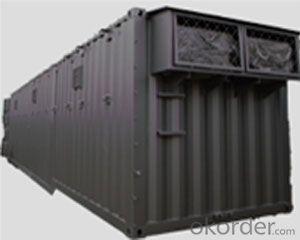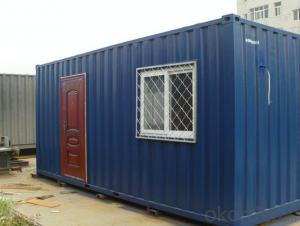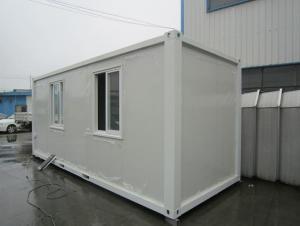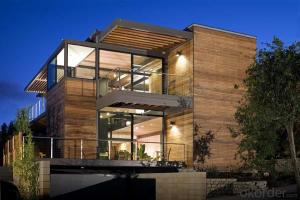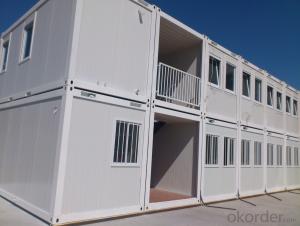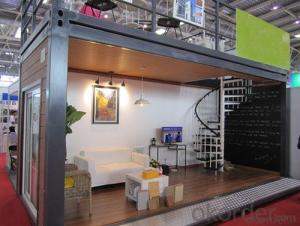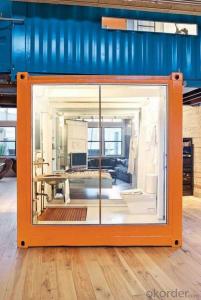Low cost Prefabricated Container House
- Loading Port:
- Tianjin
- Payment Terms:
- TT OR LC
- Min Order Qty:
- -
- Supply Capability:
- 20000 Set set/month
OKorder Service Pledge
OKorder Financial Service
You Might Also Like
Cheap Price but High Quality Two Storey Prefabricated Container Mobile House
Affordable Prefabricated Container Mobile House
Low cost Prefabricated Container House
Dimension | (1)External diameter:L 6058mmX W 2438mmXH 2896mm (2)Internal diameter: L 5820mmXW 2200mmXH 2680mm |
Area | 15m2 or 30m2 or other size |
Color | White grey, blue---as your require |
Weight | 2000kg/20ft;4000kg/40ft |
Lifetime | 20-25 years |
Steel Frame | 4mm thickness steel pillar (baking finish)+3mm steel beam (Hot-galvanized) |
Wall Panel | 60mm EPS/Rockwool/PU sandwich panel |
Roof | (1)First layer: 0.5mm Hot-galvanized steel sheet (2)Second layer: 100mm glass wool insulation (3)Third layer: 50mm EPS/PU/Rockwool Sandwich Panel |
Bottom | (1)First layer:1.8 mm PVC floor (2)Second layer:18mm plywood for office,living etc. Cement fiberboard for bathroom with good water-proof (3)Third layer:100mm Insulation (4)Forth layer:0.5mm Hot-galvanized steel sheet |
Door/windows | one steel door and two PVC sliding windows |
Electricity | (1)1 distribution box;1 circuit breaker; (2)2 Ceiling lights ; 3 sockets(1 is A/C socket); (3)1 switch; |
Usage | Accommodation,office,living room,hotel,meeting room, dormitory, shop, booth, toilet, storage, kitchen, shower room and so on. |
Package | (1) 4 sets Flat-packing without shipping container (2) 6 sets loading in 40'High shipping Container; (3)The inner shower room and other furniture will be packed separately in shipping container. |
- Q:Are container houses resistant to earthquakes?
- Container houses are generally considered to be resistant to earthquakes. The structural integrity of shipping containers makes them inherently strong and durable, capable of withstanding various external forces, including seismic activity. These containers are typically made of steel, which is a highly robust and flexible material that can absorb and distribute the energy from an earthquake. In addition, container houses can be reinforced by adding additional steel supports or bracing to further enhance their resistance to earthquakes. However, it is important to note that the level of earthquake resistance may vary depending on the design, construction, and location of the container house. Professional engineering evaluations and adherence to local building codes and regulations are crucial in ensuring that container houses are adequately designed and built to withstand seismic forces.
- Q:Are container houses aesthetically pleasing?
- The aesthetic appeal of container houses is subjective and varies from person to person. Some people find the industrial and minimalist design of container houses to be aesthetically pleasing, appreciating the unique and modern look they offer. Others may prefer more traditional or conventional architectural styles. Ultimately, whether container houses are considered aesthetically pleasing is a matter of personal taste and preference.
- Q:Can container houses be designed for community centers or gathering spaces?
- Certainly, community centers or gathering spaces can indeed be designed and repurposed using container houses. The versatility and adaptability of shipping containers are among their key advantages for such purposes. These structures can be easily modified, stacked, or combined to create larger spaces, making them well-suited for community centers or gathering spaces of varying sizes. By incorporating windows, doors, insulation, and other necessary amenities, container houses can be transformed into vibrant and functional community centers. The open floor plan of a container allows for flexible interior design options, enabling the creation of multi-purpose spaces that can cater to different activities like meetings, workshops, classes, or social gatherings. Furthermore, container houses can be customized to include features such as a kitchenette, restrooms, storage areas, or even outdoor spaces like patios or gardens. They can also be equipped with sustainable technologies like solar panels or rainwater harvesting systems to reduce energy consumption, making them environmentally friendly choices for community centers. The relatively lower cost of container houses compared to traditional construction adds to their attractiveness as an option for community centers or gathering spaces, especially for organizations or communities with limited budgets. They can be quickly built, easily transported, and installed in different locations, providing flexibility and accessibility to serve various communities. In summary, container houses can be designed and repurposed to create distinct and practical community centers or gathering spaces. Their versatility, adaptability, cost-effectiveness, and potential for sustainability make them an excellent choice for organizations or communities seeking to establish a dynamic and inclusive space for their members to convene.
- Q:Can container houses be designed to have a walk-in closet?
- Certainly, walk-in closets can absolutely be included in the design of container houses. The dimensions of the closet may vary depending on the size of the container, but it is definitely feasible to incorporate this feature. By carefully planning and making efficient use of the available space, a container house can provide a practical and visually appealing walk-in closet. Additionally, customization options such as the installation of shelves, hanging rods, shoe racks, drawers, and mirrors can further enhance the functionality and storage capacity of the closet. Ultimately, the design and layout of a container house can be personalized to cater to individual preferences and requirements, including the inclusion of a walk-in closet.
- Q:Can container houses be designed with a wine cellar?
- Yes, container houses can be designed with a wine cellar. The design and construction of a wine cellar in a container house would require careful planning and consideration of factors such as temperature control, insulation, and storage capacity. However, with the right design and modifications, it is possible to incorporate a wine cellar into a container house.
- Q:What is the difference between a container house and an activity board?
- the vertical direction can be stacked up to three layers. Box body structure is the use of special steel welded from the standard components, boxes and boxes connected by bolts, simple structure, easy installation
- Q:Are container houses prone to condensation or moisture issues?
- Container houses can be prone to condensation and moisture issues, but this largely depends on how they are designed, built, and maintained. Containers are made of steel, which is a highly conductive material that can easily transfer heat and cold. This means that without proper insulation, container houses can experience temperature differences between the inside and outside, leading to condensation. To mitigate condensation and moisture problems, several measures can be taken. Insulation is crucial, as it helps regulate the temperature inside the container and prevents temperature differences that cause condensation. Additionally, proper ventilation is essential to allow moisture to escape and to maintain a balanced humidity level. Another factor to consider is the location of the container house. If it is placed in a humid environment or an area prone to heavy rainfall, moisture issues may be more common. Adequate drainage systems, waterproofing, and regular inspections can help prevent water infiltration and subsequent moisture problems. Furthermore, routine maintenance is vital to address any potential sources of moisture. This includes checking for leaks, repairing damaged insulation, and ensuring that the ventilation system is functioning correctly. Regularly monitoring the humidity levels inside the container can also help identify and address any condensation issues before they become more severe. In summary, while container houses can be prone to condensation and moisture issues, proper insulation, ventilation, location considerations, and maintenance can significantly minimize these problems.
- Q:Are container houses resistant to termites or other wood-damaging insects?
- Yes, container houses are typically resistant to termites and other wood-damaging insects. Since container houses are primarily made of steel, which is not a food source for termites, they are less susceptible to termite infestations compared to traditional wood-framed houses. However, it is still important to ensure proper insulation and sealing to prevent any potential entry points for insects.
- Q:Can container houses be designed with multiple levels?
- Yes, container houses can definitely be designed with multiple levels. The modular nature of shipping containers allows for easy stacking and joining, making it possible to create multi-story structures. In fact, many architects and designers have successfully incorporated multiple levels in container house designs, showcasing the versatility and flexibility of this building method. When designing container houses with multiple levels, certain considerations need to be taken into account. The structural integrity of the containers must be maintained, and additional support may be required to ensure the stability of the upper levels. Proper insulation and ventilation systems should also be incorporated to maintain a comfortable living environment throughout the entire structure. Moreover, it is essential to carefully plan the layout and design of each level to optimize space and functionality. Creating an efficient flow between the different floors, incorporating staircases or even elevators, and considering the placement of windows and openings are crucial aspects of designing multi-level container houses. Overall, container houses can be successfully designed with multiple levels, offering a unique and innovative solution for those seeking compact yet spacious living spaces.
- Q:Can container houses be off-grid?
- Yes, container houses can be off-grid. One of the advantages of container houses is their flexibility, which allows for various sustainable living options. To achieve off-grid living, container houses can be equipped with solar panels to generate electricity. These panels can be installed on the roof or nearby to harness sunlight and convert it into usable energy. Additionally, container houses can incorporate rainwater harvesting systems to collect and store rainwater for everyday needs. Some container houses also utilize composting toilets and graywater recycling systems to minimize water usage. By combining these eco-friendly technologies, container houses can operate independently from the traditional power grid and water supply, making them an ideal option for off-grid living.
1. Manufacturer Overview |
|
|---|---|
| Location | |
| Year Established | |
| Annual Output Value | |
| Main Markets | |
| Company Certifications | |
2. Manufacturer Certificates |
|
|---|---|
| a) Certification Name | |
| Range | |
| Reference | |
| Validity Period | |
3. Manufacturer Capability |
|
|---|---|
| a)Trade Capacity | |
| Nearest Port | |
| Export Percentage | |
| No.of Employees in Trade Department | |
| Language Spoken: | |
| b)Factory Information | |
| Factory Size: | |
| No. of Production Lines | |
| Contract Manufacturing | |
| Product Price Range | |
Send your message to us
Low cost Prefabricated Container House
- Loading Port:
- Tianjin
- Payment Terms:
- TT OR LC
- Min Order Qty:
- -
- Supply Capability:
- 20000 Set set/month
OKorder Service Pledge
OKorder Financial Service
Similar products
New products
Hot products
Hot Searches
Related keywords
